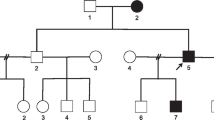Abstract
X-linked Charcot–Marie–Tooth disease (CMT1X) is the second most common variant of CMT and is caused by mutations in the GJB1 gene encoding connexin 32. Some CMT1X patients with GJB1 missense mutations have shown transient central nervous system (CNS) symptoms with abnormal brain magnetic resonance imaging (MRI). Herein we report the first case with a novel GJB1 frameshift mutation that associates with a transient CNS symptom. The patient noticed high-arched feet and limited ankle dorsiflexion in early childhood; he transiently developed numbness and paresis of left face and arm, and dysphagia, with abnormal brain MRI. Although the CNS symptoms recovered within several hours without treatment, intravenous immunoglobulin (IVIg) therapy ameliorated progressing symptoms such as those of toe extensor muscles. His mother had been diagnosed with chronic inflammatory demyelinating polyneuropathy (CIDP), and repetitive IVIg treatments had relieved the symptoms. Therefore, inflammation might be involved in the pathophysiology of CMT1X with the GJB1 mutation, while molecular analysis revealed that the mutant GJB1 was more rapidly degraded by the proteasome pathway known as endoplasmic reticulum (ER)-associated degradation.



Similar content being viewed by others
References
Bergoffen J, Scherer SS, Wang S et al (1993) Connexin mutations in X-linked Charcot–Marie–Tooth disease. Science 262:2039–2042
Nicholson G, Corbett A (1996) Slowing of central conduction in X-linked Charcot–Marie–Tooth neuropathy shown by brain stem auditory evoked responses. J Neurol Neurosurg Psychiatry 61:43–46
Panas M, Karadimas C, Avramopoulos D, Vassilopoulos D (1998) Central nervous system involvement in four patients with Charcot–Marie–Tooth disease with connexin 32 extracellular mutations. J Neurol Neurosurg Psychiatry 65:947–948
Stojkovic T, Latour P, Vandenberghe A, Hurtevent JF, Vermersch P (1999) Sensorineural deafness in X-linked Charcot–Marie–Tooth disease with connexin 32 mutation (R142Q). Neurology 52:1010–1014
Kawakami H, Inoue K, Sakakihara I, Nakamura S (2002) Novel mutation in X-linked Charcot–Marie–Tooth disease associated with CNS impairment. Neurology 59:923–926
Taylor RA, Simon EM, Marks HG, Scherer SS (2003) The CNS phenotype of X-linked Charcot–Marie–Tooth disease: more than a peripheral problem. Neurology 61:1475–1478
Srinivasan J, Leventer RJ, Kornberg AJ, Dahl HH, Ryan MM (2008) Central nervous system signs in X-linked Charcot–Marie–Tooth disease after hyperventilation. Pediatr Neurol 38:293–295
Schelhaas HJ, Van Engelen BG, Gabreels-Festen AA et al (2002) Transient cerebral white matter lesions in a patient with connexin 32 missense mutation. Neurology 59:2007–2008
Hanemann CO, Bergmann C, Senderek J, Zerres K, Sperfeld AD (2003) Transient, recurrent, white matter lesions in X-linked Charcot–Marie–Tooth disease with novel connexin 32 mutation. Arch Neurol 60:605–609
Lee MJ, Nelson I, Houlden H et al (2002) Six novel connexin32 (GJB1) mutations in X-linked Charcot–Marie–Tooth disease. J Neurol Neurosurg Psychiatry 73:304–306
Ressot C, Gomes D, Dautigny A, Pham-Dinh D, Bruzzone R (1998) Connexin32 mutations associated with X-linked Charcot–Marie–Tooth disease show two distinct behaviors: loss of function and altered gating properties. J Neurosci 18:4063–4075
Ionasescu V, Ionasescu R, Searby C (1996) Correlation between connexin 32 gene mutations and clinical phenotype in X-linked dominant Charcot–Marie–Tooth neuropathy. Am J Med Genet 63:486–491
Shy ME, Siskind C, Swan ER et al (2007) CMT1X phenotypes represent loss of GJB1 gene function. Neurology 68:849–855
Dyck PJ, Swanson CJ, Low PA, Bartleson JD, Lambert EH (1982) Prednisone-responsive hereditary motor and sensory neuropathy. Mayo Clin Proc 57:239–246
Bird SJ, Sladky JT (1991) Corticosteroid-responsive dominantly inherited neuropathy in childhood. Neurology 41:437–439
Malandrini A, Villanova M, Dotti MT, Federico A (1999) Acute inflammatory neuropathy in Charcot–Marie–Tooth disease. Neurology 52:859–861
Ginsberg L, Malik O, Kenton AR et al (2004) Coexistent hereditary and inflammatory neuropathy. Brain 127:193–202
Vital A, Vital C, Lagueny A et al (2003) Inflammatory demyelination in a patient with CMT1A. Muscle Nerve 28:373–376
Scherer SS, Xu YT, Nelles E et al (1998) Connexin32-null mice develop demyelinating peripheral neuropathy. Glia 24:8–20
Maurer M, Kobsar I, Berghoff M et al (2002) Role of immune cells in animal models for inherited neuropathies: facts and visions. J Anat 200:405–414
Kobsar I, Berghoff M, Samsam M et al (2003) Preserved myelin integrity and reduced axonopathy in connexin32-deficient mice lacking the recombination activating gene-1. Brain 126:804–813
Carenini S, Maurer M, Werner A et al (2001) The role of macrophages in demyelinating peripheral nervous system of mice heterozygously deficient in p0. J Cell Biol 152:301–308
Acknowledgments
This work was partly supported by grants-in-aid from the Research Committee of CNS Degenerative Diseases, the Ministry of Health, Labor, and Welfare of Japan.
Author information
Authors and Affiliations
Corresponding author
Additional information
H. Sakaguchi and S. Yamashita contributed equally to this work.
Rights and permissions
About this article
Cite this article
Sakaguchi, H., Yamashita, S., Miura, A. et al. A novel GJB1 frameshift mutation produces a transient CNS symptom of X-linked Charcot–Marie–Tooth disease. J Neurol 258, 284–290 (2011). https://doi.org/10.1007/s00415-010-5752-8
Received:
Accepted:
Published:
Issue Date:
DOI: https://doi.org/10.1007/s00415-010-5752-8




